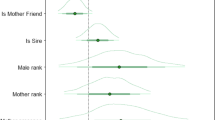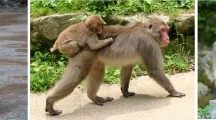Abstract
In several cercopithecine species males exhibit a specific type of male–infant–male interaction during which two males briefly manipulate an infant. These interactions typically occur after a male carrying an infant (infant holder) approaches or is approached by another male who is not holding an infant (infant nonholder). The agonistic buffering and relationship management hypotheses explain these interactions as a tool to establish and maintain social bonds among males. Both hypotheses predict that males preferentially use the opportunity to interact and bond with males dominant to themselves. However, the agonistic buffering hypothesis predicts that males preferentially initiate male–infant–male interactions with the highest ranking males available, whereas the relationships management hypothesis predicts that males are more likely to interact with males that are close to them in rank. To test these predictions, we collected data on 1562 male–infant–male interactions during 1430 hours of focal observation of 12 infants in one group of wild Barbary macaques (Macaca sylvanus) in Morocco. Using generalized linear mixed-effect models we found that males preferably initiated interactions with males that were dominant to them. However, we observed this effect only for interactions initiated by the infant holder. In interactions initiated by non-holders, the receiver’s relative rank did not predict the frequency of interactions. Males also initiated more interactions with males close in rank to themselves than distantly ranked males. Our results support the relationship management hypothesis, but also indicate that the different types of male–infant–male interactions may require different explanations.


Similar content being viewed by others
References
Altmann, J. (1974). Observational study of behavior: Sampling methods. Behaviour, 49(3), 227–266.
Bates, D., Maechler, M., Bolker, B., Walker, S., & others. (2014). lme4: Linear mixed-effects models using Eigen and S4. R package version, 1(7), 1–23.
Bauer, B., Sheeran, L. K., Matheson, M. D., Li, J.-H., & Wagner, R. S. (2014). Male Tibetan macaques (Macaca thibetana) choice of infant bridging partners. Zoological Research, 35(3), 222–230.
Berghänel, A., Schülke, O., & Ostner, J. (2010). Coalition formation among Barbary macaque males: The influence of scramble competition. Animal Behaviour, 80(4), 675–682.
Berghänel, A., Ostner, J., Schröder, U., & Schülke, O. (2011). Social bonds predict future cooperation in male Barbary macaques, Macaca sylvanus. Animal Behaviour, 81(6), 1109–1116.
Bernstein, I. S., & Cooper, M. A. (1998). Ambiguities in the behavior of Assamese macaques. American Journal of Primatology, 45, 170–171.
Bissonnette, A., de Vries, H., & van Schaik, C. P. (2009). Coalitions in male Barbary macaques, Macaca sylvana: strength, success and rules of thumb. Animal Behaviour, 78(2), 329–335.
Busse, C. D., & Gordon, T. P. (1984). Infant carrying by adult male mangabeys (Cercocebus atys). American Journal of Primatology, 6(3), 133–141.
Busse, C., & Hamilton, W. J. (1981). Infant carrying by male chacma baboons. Science, 212(4500), 1281–1283.
Chalmers, N. R. (1968). The social behaviour of free living mangabeys in Uganda. Folia Primatologica, 8(3–4), 263–281.
Collins, D. A. (1986). Interactions between adult male and infant yellow baboons (Papio c. cynocephalus) in Tanzania. Animal Behaviour, 34(2), 430–443.
De Vries, H., Stevens, J. M., & Vervaecke, H. (2006). Measuring and testing the steepness of dominance hierarchies. Animal Behaviour, 71(3), 585–592.
de Waal, F. B., van Hooff, J. A., & Netto, W. J. (1976). An ethological analysis of types of agonistic interaction in a captive group of Java-monkeys (Macaca fascicularis). Primates, 17(3), 257–290.
Deag, J. M. (1974). A study of the social behavior and ecology of the wild Barbary macaque, Macaca sylvanus, L. 1758. Unpublished doctoral dissertation, University of Bristol.
Deag, J. M. (1980). Interactions between males and unweaned Barbary macaques: Testing the agonistic buffering hypothesis. Behaviour, 75, 54–81.
Deag, J. M., & Crook, J. H. (1971). Social behaviour and ‘agonistic buffering’ in the wild Barbary macaque Macaca sylvana L. Folia Primatologica, 15(3–4), 183–200.
Dunbar, R. I. M. (1984). Infant-use by male gelada in agonistic contexts: Agonistic buffering, progeny protection or soliciting support? Primates, 25(1), 28–35.
Estrada, A., & Sandoval, J. M. (1977). Social relations in a free-ranging troop of stumptail macaques (Macaca arctoides): Male-care behaviour I. Primates, 18(4), 793–813.
Henkel, S., Heistermann, M., & Fischer, J. (2010). Infants as costly social tools in male Barbary macaque networks. Animal Behaviour, 79(6), 1199–1204.
Holm, S. (1979). A simple sequentially rejective multiple test procedure. Scandinavian Journal of Statistics, 6, 65–70.
Kalbitz, J., Schülke, O., & Ostner, J. (2017). Triadic male-infant-male interaction serves in bond maintenance in male Assamese macaques. PLoS One, 12(10), e0183981.
Kleindorfer, S., & Wasser, S. (2004). Infant handling and mortality in yellow baboons (Papio cynocephalus): Evidence for female reproductive competition? Behavioral Ecology and Sociobiology, 56(4), 328–337.
Kuester, J., & Paul, A. (1992). Influence of male competition and female mate choice on male mating success in Barbary macaques (Macaca sylvanus). Behaviour, 120(3), 192–216.
Kuběnová, B., Konečná, M., Majolo, B., Šmilauer, P., Ostner, J., & Schülke, O. (2017). Triadic awareness predicts partner choice in male–infant–male interactions in Barbary macaques. Animal Cognition, 20(2), 221–232.
Kümmerli, R., & Martin, R. D. (2008). Patterns of infant handling and relatedness in Barbary macaques (Macaca sylvanus) on Gibraltar. Primates, 49(4), 271–282.
Maestripieri, D. (1994). Social structure, infant handling, and mothering styles in group-living Old World monkeys. International Journal of Primatology, 15(4), 531–553.
Maestripieri, D. (1997). Gestural communication in macaques: Usage and meaning of nonvocal signals. Evolution of Communication, 1(2), 193–222.
McFarland, R., & Majolo, B. (2011). Grooming coercion and the post-conflict trading of social services in wild Barbary macaques. PLoS One, 6(10), e26893.
Ménard, N., von Segesser, F., Scheffrahn, W., Pastorini, J., Vallet, D., et al (2001). Is male-infant caretaking related to paternity and/or mating activities in wild Barbary macaques (Macaca sylvanus)? Comptes Rendus de l’Académie des Sciences. Série III, Sciences de la Vie, 324(7), 601.
Minge, C., Berghänel, A., Schülke, O., & Ostner, J. (2016). Patterns and consequences of male–infant relationships in wild Assamese macaques (Macaca assamensis). International Journal of Primatology, 37(3), 350–370.
Mitani, J. C. (2009). Male chimpanzees form enduring and equitable social bonds. Animal Behaviour, 77(3), 633–640.
Ogawa, H. (1995). Bridging behavior and other affiliative interactions among male Tibetan macaques (Macaca thibetana). International Journal of Primatology, 16(5), 707–729.
Packer, C. (1980). Male care and exploitation of infants in Papio anubis. Animal Behaviour, 28(2), 512–520.
Paul, A. (1999). The socioecology of infant handling in primates: Is the current model convincing? Primates, 40(1), 33–46.
Paul, A., Kuester, J., & Arnemann, J. (1996). The sociobiology of male-infant interactions in Barbary macaques, Macaca sylvanus. Animal Behaviour, 51(1), 155–170.
Preuschoft, S., Paul, A., & Kuester, J. (1998). Dominance styles of female and male Barbary macaques (Macaca sylvanus). Behaviour, 135(6), 731–755.
Preuschoft, S., & van Schaik, C. P. (2000). Dominance and communication. In F. Aureli & F. B. M. de Waal (Eds.), Natural conflict resolution (pp. 77–105). Berkeley: University of California Press.
R Core Team (2014). R: A language and environment for statistical computing. R Foundation for Statistical Computing, Vienna, Austria. 2013.
Schino, G., Speranza, L., Ventura, R., & Troisi, A. (2003). Infant handling and maternal response in Japanese macaques. International Journal of Primatology, 24(3), 627–638.
Seyfarth, R. M. (1976). Social relationships among adult female baboons. Animal Behaviour, 24(4), 917–938.
Silk, J. B. (1994). Social relationships of male bonnet macaques: Male bonding in a matrilineal society. Behaviour, 130(3), 271–291.
Silk, J. B., & Samuels, A. (1984). Triadic interactions among Macaca radiata: Passports and buffers. American Journal of Primatology, 6(4), 373–376.
Smith, E. O., & Peffer-Smith, P. G. (1982). Triadic interactions in captive Barbary macaques (Macaca sylvanus, Linnaeus, 1758): “Agonistic buffering”? American Journal of Primatology, 2(1), 99–107.
Smuts, B. B. (1985). Sex and friendship in baboons. New York: Aldine.
Stein, D. M. (1981). The nature and function of social interactions between infant and adult male yellow baboons (Papio cynocephalus). In PhD thesis. University of Chicago.
Stein, D. M. (1984). The sociobiology of infant and adult male baboons (Vol. 5). Norwood: Ablex Publishing Corporation.
Taub, D. M. (1980). Testing the ‘agonistic buffering’ hypothesis. Behavioral Ecology and Sociobiology, 6(3), 187–197.
Taub, D. M. (1984). Male caretaking behavior among wild Barbary macaques (Macaca sylvanus). In D. M. Taub (Ed.), Primate paternalism (pp. 20–55). New York: Van Nostrand Reinhold.
Thierry, B., Bynum, E., Baker, S., Kinnaird, M., Matsumura, S., et al (2000). The social repertoire of Sulawesi macaques. Primate Research, 16, 203–226.
Trivers, R. (1972). Parental investment and sexual selection. In B. Campbell (Ed.), Sexual selection and the descent of man (pp. 136–176). London: Heinemann.
Van Schaik, C. P., & Paul, A. (1996). Male care in primates: Does it ever reflect paternity? Evolutionary Anthropology: Issues, News, and Reviews, 5(5), 152–156.
Whitten, P. L. (1987). Infants and adult males. In B. B. Smuts, D. L. Cheney, R. M. Seyfarth, & T. T. Struhsaker (Eds.), Primate societies (pp. 343–357). Chicago: University of Chicago Press.
Widdig, A., Streich, W. J., & Tembrock, G. (2000). Coalition formation among male Barbary macaques (Macaca sylvanus). American Journal of Primatology, 50(1), 37–51.
Wiper, S. M., & Semple, S. (2007). The function of teeth chattering in male Barbary macaques (Macaca sylvanus). American Journal of Primatology, 69(10), 1179–1188.
Young, C., Hähndel, S., Majolo, B., Schülke, O., & Ostner, J. (2013). Male coalitions and female behaviour affect male mating success independent of dominance rank and female receptive synchrony in wild Barbary macaques. Behavioral Ecology and Sociobiology, 67(10), 1665–1677.
Young, C., Majolo, B., Heistermann, M., Schülke, O., & Ostner, J. (2014). Responses to social and environmental stress are attenuated by strong male bonds in wild macaques. Proceedings of the National Academy of Sciences of the USA, 111(51), 18195–18200.
Zhao, Q.-K. (1996). Male-infant-male interactions in Tibetan macaques. Primates, 37(2), 135–143.
Acknowledgments
This study was supported by grant 009/2014/P and 04-151/2016/P provided by the Grant Agency of the University of South Bohemia, Christian-Vogel Fond for Field Research of the Gesellschaft für Primatologie and by a scholarship of the German Academic Exchange Service DAAD. We are grateful to the Haut Commissariat aux Eaux et Forêts et à la Lutte Contre la Desertification of Morocco for research permission and professor Mohamed Mouna (Institute Scientsifique, Rabat, Morocco) and professor Mohamed Quarro (Ecole Nationale Forestière d’Ingénieurs, Salé, Morocco) for their invaluable support and cooperation during the field work. We appreciate the advice and support of Josephine Kalbitz, Adeelia Goffe, Andreas Berghänel, Christopher Young, Christina Haunhorst, and Stanislav Lhota. We are particularly thankful to James Waterman for his support and comments on the earlier version of the manuscript. We also want to thank Dr. Joanna Setchell, Dr. Daphne Kerhoas, and one anonymous referee for their thoughtful and insightful comments on the manuscript.
B. Kuběnová, O. Schülke, J. Ostner, and M. Konečná conceived the idea, formulated the aims of the study, and designed the methodology; B. Majolo provided the study site; B. Kuběnová conducted field work and collected data; P. Šmilauer and B. Kuběnová performed statistical analysis; and B. Kuběnová, O. Schülke, J. Ostner, B. Majolo, and M. Konečná wrote the manuscript.
Author information
Authors and Affiliations
Corresponding author
Additional information
Handling Editor: Joanna M. Setchell
Rights and permissions
About this article
Cite this article
Kuběnová, B., Ostner, J., Schülke, O. et al. The Effect of Dominance Rank on the Distribution of Different Types of Male–Infant–Male Interactions in Barbary Macaques (Macaca sylvanus). Int J Primatol 40, 300–315 (2019). https://doi.org/10.1007/s10764-019-00086-x
Received:
Accepted:
Published:
Issue Date:
DOI: https://doi.org/10.1007/s10764-019-00086-x




